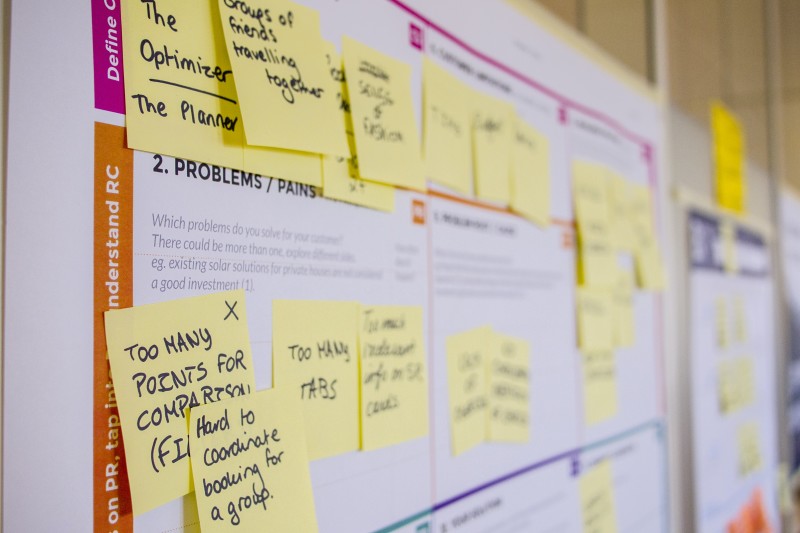The way we develop new products has changed dramatically over the last few years. Rather than worrying about being first to market with a new innovation, businesses are building products that offer real value to the customer.
Product managers are taking a step back and allowing their teams to create a product in a way that works for them.
By focusing on outcomes instead of writing those old-fashioned, dreaded, heavily-dictated development plans, product can ensure that their development counterparts are performing at their best to bring maximum value to the customer upon release.
We can also apply this mentality to problem-solving. Instead of leaving the team with a specific step-by-step process to fix issues, we see simple guidelines that convey what the problem is, how to solve it, and why the decision has been made to solve it this way.
Step by step template for writing a problem outline
Let’s set the scene. Your team is building a new mobile application when they discover the color scheme they’re using isn’t suitable for colorblind users. Your product problem outline would look something like this:
The problem
To come up with a solution, the team needs to fully understand the problem. This understanding will help solve said problem in a way that adds real value.
In this case, the surface issue is that the color scheme makes it difficult for colorblind users to distinguish which button does which action. The obvious answer is to change the color scheme, but that simply places a bandaid on the problem rather than truly solving it at a larger scale.
Ultimately, this issue boils down to accessibility. If accessibility has been overlooked on something as fundamental as the application’s design, there’s a high chance other product areas will have accessibility issues too.
Rather than focusing on one solution, you can take a step back and ask: what else could we do to improve accessbility for our users? I This is essential to fully assess the problem and gain a holistic perspective going forward.

Hypothesis
This second step is about looking at hypothetical situations that could come from solving the issue at hand. Ideally, you will develop situations that demonstrate both positive and negative aspects of solving the problem.
Essentially, this step asks, “What will the likely outcome be if this problem is solved?”
Will it promote accessibility throughout the company’s other products? Will it bring in new customers? Will it make things difficult for other users who are not colorblind? Will the product still look great?
Once you have answered these types of questions, you will have a full picture of the results.
Customer value
Customer-centricity is key to a successful product. In this situation, addressing an accessibility issue is a clear way of adding value for the customer. However, it’s not always so cut and dry.
Make sure to question if the solution to your problem will benefit the customer. If there is no added value for the customer, there’s no reason to work on the issue.
Company value
Throughout the entire development process, you should always be asking what value the product will bring to the company. This helps keep the development team aligned with company goals and your overall mission statement.
You should apply the same mindset to problem-solving. If solving this issue won’t bring value to the company, is it worth the team’s time?

Main action points
Now we have identified the problem and how solving that problem can increase the product value, it’s time to start tackling it.
During this step, you will collect ideas for tasks you’ll need to perform to solve the issue. The previous steps should have already sparked some ideas, but don’t be afraid to perform some basic discovery if the problem requires some extra input.
Thinking about the current example, you could create a bullet point list that outlines the main action points, such as:
Research color schemes
Understand how this fits with the design system
Use different shapes for different action buttons
Documentation
A problem outline should include every piece of information that you’ve gathered. The outline should be your source of truth that features the facts and relevant data to guide the problem-solving process.
Measuring success
One of the most critical steps in problem-solving is establishing how to measure success. In our scenario, it’s relatively simple to measure success during testing, as testers can ensure the application’s workflow is more accessible while still being as seamless as before.
Establishing the measurements of success gives the team a goal to aim for to help them create a solution.
The benefits to using this type of problem outline template
Offering your development team this kind of outline allows them to focus on and build problem-solving skills. The loose guidelines help promote creativity and push them to consider solutions that may be a little out of the box. Not only will this help solve the problem at hand, but it will also empower them to make crucial decisions in the future that could solve problems before they arise.
It also allows the team to look at projects from a holistic standpoint. Rather than focusing on the end result, they can focus on what they need to do to achieve it to bring value to the product.

Andrea Saez

Read also
Experience the new way of doing product management





